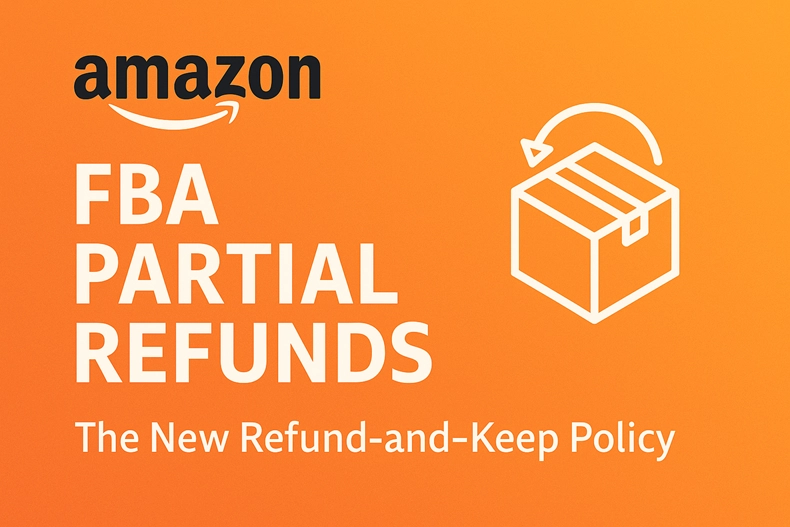Amazon Launches FBA Partial Refunds (October 2025): The “Refund-and-Keep” Era Begins
Amazon Launches FBA Partial Refunds (October 2025): The “Refund-and-Keep” Era Begins

In October 2025, Amazon quietly launched a new feature called FBA Partial Refunds – a policy that allows sellers in the US, UK, Germany, France, Italy, and Spain to offer customers a partial refund without requiring them to send the product back.
At first glance, it looks like a gift: fewer returns, lower costs, happier customers.
But like every major Amazon update, the real impact lies beneath the surface.
This isn’t just another convenience feature. It’s the start of a new era in how Amazon manages post-purchase experiences – one that shifts risk, data, and decision power in subtle ways most sellers won’t notice until it’s too late.
What Amazon Actually Introduced
The new FBA Partial Refunds program lets sellers refund a portion of a customer’s payment (say 10–40%) while allowing the buyer to keep the item.
Here’s the official summary straight from Seller Central (Amazon Help Page, Oct 2025):
Eligibility: Non-hazmat, non-hygiene, non-restricted FBA items.
Markets: US, UK, DE, FR, IT, ES.
Setup: Enable globally or upload a CSV with ASIN-level percentages.
Execution: If the customer qualifies, Amazon issues the refund automatically – no label, no shipping, no warehouse return.
It’s positioned as an efficiency tool. But efficiency in Amazon’s world always comes with fine print.
Why Amazon Really Launched It
Returns are one of Amazon’s biggest financial drains.
Each low-value FBA item that ships back through the network costs more to process than it’s worth.
The FBA Partial Refunds feature lets Amazon:
Slash operational costs (no inbound shipping or inspection).
Keep customers happier with instant resolution.
Transfer the responsibility for refund losses directly to sellers.
It’s a clever pivot: Amazon protects customer satisfaction metrics, and sellers foot the cost – all under the banner of “choice.”
The Hidden Trade-Offs Sellers Can’t Ignore
⚠️ It still counts as a return
Even though the item isn’t coming back, Amazon still marks it as a return event.
That means:
It contributes to your ASIN’s average return rate.
It can trigger the “Frequently Returned” badge.
It doesn’t incur the high return rate fee, since no logistics cost applies.
So yes – you save money, but you still risk metric exposure.
⚠️ You lose both the product and the data
No return = no inspection.
You lose visibility into what actually went wrong – damaged packaging, design flaw, or buyer error.
For compliance-driven brands, that’s serious. Without product-level feedback, you can’t close the loop on quality or supplier accountability.
⚠️ You’re not reimbursed for the item
Amazon refunds your referral fee (minus admin cost), but the product itself is gone.
For a $12 cable, that’s acceptable.
For a $90 skincare kit or electronic accessory, it’s margin suicide.
⚠️ There’s no dedicated reporting (yet)
As of launch, no downloadable FBA Partial Refunds report exists.
You’ll need to track manually through the Manage Returns dashboard or API exports.
That means you won’t easily see trends, repeat refunders, or abuse patterns.
⚠️ Abuse risk is real
Amazon claims it uses algorithms to screen for fraud, but early forum chatter says otherwise.
Some customers are already discovering they can claim minor defects, trigger a partial refund, and keep the product.
Until data visibility improves, sellers will have to trust the system – and that’s never been a winning strategy.
Where This Program Can Work
Think of FBA Partial Refunds as a scalpel, not a hammer.
| Use Case | When to Use It | When to Avoid It |
|---|---|---|
| Low-value items (< $25) | When shipping costs exceed product cost | High-ticket SKUs – profit erosion risk |
| Consumables / accessories | Refund convenience drives loyalty | Regulated / hygiene items – ineligible |
| High-volume Q4 periods | Reduces returns backlog | New launches or premium brands – protect perception |
The ASA Playbook for Safe Implementation
Phase 1 – Pilot
Start with 5–10 ASINs under $25 retail.
Set refund percentages at 10–20%.
Track profitability and feedback over 60–90 days.
Phase 2 – Define Guardrails
Write internal rules:
“Partial refunds allowed only on SKUs under $30 with 25%+ margin.”
Exclude safety, IP-sensitive, or premium listings.
Phase 3 – Monitor Manually
Until Amazon adds reporting, log every partial refund event in your CRM or profit tracker.
Flag repeat customers.
Phase 4 – Review Quarterly
Compare before/after metrics: refund cost saved vs. margin lost.
Disable any ASINs that cross your ROI threshold.
Compliance, Tax, and Legal Implications
VAT: In EU markets, a “refund without return” may still count as a taxable event. Get tax counsel.
Warranty: If a defective product is kept, you might still owe replacements.
Accounting: Record as a discounted refund, not a destroyed unit – crucial for accurate COGS.
What This Means in the Bigger Picture
Amazon’s FBA Partial Refunds aren’t just about returns – they’re about risk transfer.
The platform is slowly automating refund resolution, reducing its own costs, and letting sellers take on the liability.
It’s the same trajectory as:
Returnless Refunds (2020s)
Customer Concession Automation
AI-based refund approval systems
The lesson: Amazon’s automation always comes dressed as convenience.
ASA’s Expert Recommendation
Treat FBA Partial Refunds as a controlled experiment – not a permanent toggle.
Use it for convenience where risk is low.
Measure relentlessly.
And never forget: faster refunds help customers, but Amazon built this to help Amazon.
If you want clarity on which SKUs to enroll – and the exact refund percentage that protects profit while satisfying policy – our compliance analysts can model it for you.
We help Amazon sellers make policy-proof decisions that protect profitability, account health, and brand trust.
Contact us to run a Refund Risk Assessment for your catalog before enabling FBA Partial Refunds.
